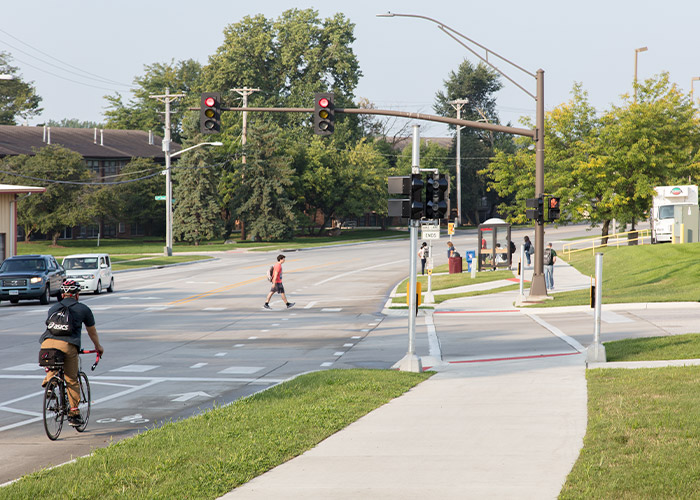Road Diet: Solving Traffic Problems with Fewer Lanes
When congestion on roads increases, the usual step is to widen the road and add more lanes. However, sometimes congestion is not caused by a higher volume of vehicles.
When congestion on roads increases, the usual step is to widen the road and add more lanes. However, sometimes congestion is not caused by a higher volume of vehicles.

When congestion on roads increases, the usual step is to widen the road and add more lanes. However, congestion is not always caused by higher volume of vehicles. Ideal candidates for road diets are roads that see less than 18,000 vehicles a day and have a high number of conflicts, such as:
Road diets are an interesting option for cities because they allow communities to make a “complete street,” one that offers room for bicyclists, buses, and parking to access local businesses. Road diets offer a lower-cost solution for increasing safety and operations.
The most common road diet is going from a four-lane road to three lanes, with two lanes of through-moving traffic and a two-way left-turn lane in the middle. The center lane can be a little wider, or include a refuge to help pedestrians cross the road safely.
The space from the former fourth lane can be turned into:

As seen above, roadways have four-lanes before a road diet and can transform into a three-lane road with two-way left-turn lanes in the middle and separate bike lanes
When commercial or residential areas build up around travel corridors, many access points such as driveways are added. Instead of a majority of through-traveling traffic, there is a shift to more turning vehicles, causing congestion and increasing crashes. By adding a two-way left-turn lane, congestion is reduced because the impediments for through-traveling vehicles are removed.
Several cities have already benefitted from converting narrow four-lane roads to three-lane roads with a middle-shared left-turn lane. A few were also able to secure funding assistance for their projects from a number of different sources.
Muscatine, Iowa
A 1.3-mile stretch along Park Avenue in Muscatine, Iowa saw 122 crashes between 2010 and 2016, the majority of these a result of turning vehicles on the undivided four-lane corridor, as they were rear-end, angle oncoming and broadside collisions. With no dedicated turning lanes, vehicles entering onto and turning from Park Avenue were part of the through traffic, creating many points of conflict. After helping Muscatine secure Traffic Safety Improvement Program (TSIP) funds, this led to getting other funding including pedestrian curb ramp funds and 3R (Resurfacing, Restoration and Rehabilitation) funds to pay for not only the road diet but resurfacing of the road, bringing the signalized intersections into ADA compliance and updating the signals.
Ames, Iowa
In Ames, Iowa, when converting South Third Street to three lanes, creating a “complete street” was a priority as it is a college town that sees heavy pedestrian traffic. The space from the fourth lane was converted into bike lanes on each side of the road.
Clinton, Iowa
Third Street in Clinton, Iowa met all of the criteria for a road diet, with a high number of access points, higher-than-normal crash rate and narrow lanes. The City was able to secure TSIP funds to pay for the improvements. Signalized intersections were updated, with curb ramps and push-button pedestrian signals added.
Some residents might worry that there’ll be more congestion when lanes are removed. Once they drive the road after changes are made, however, they see traffic flow increase because most of the road conflicts are removed from the traveling lanes. While a “road diet” might not be the first solution thought of when traffic congestion problems arise, they can be another useful option for cities that benefits both the community and drivers.